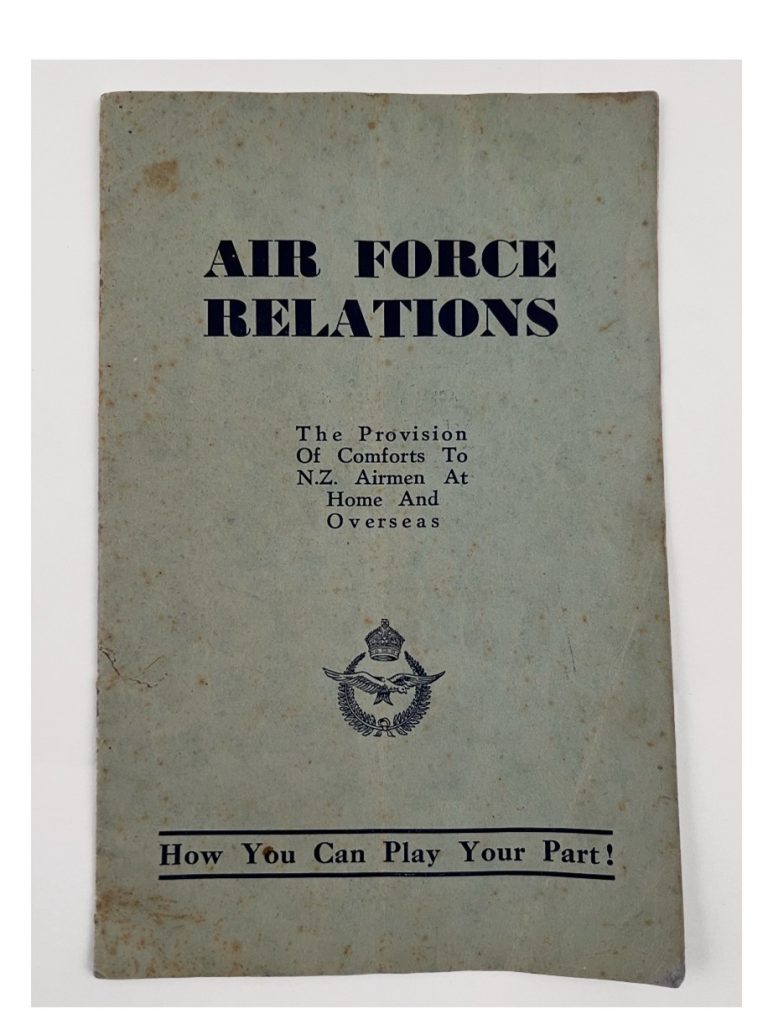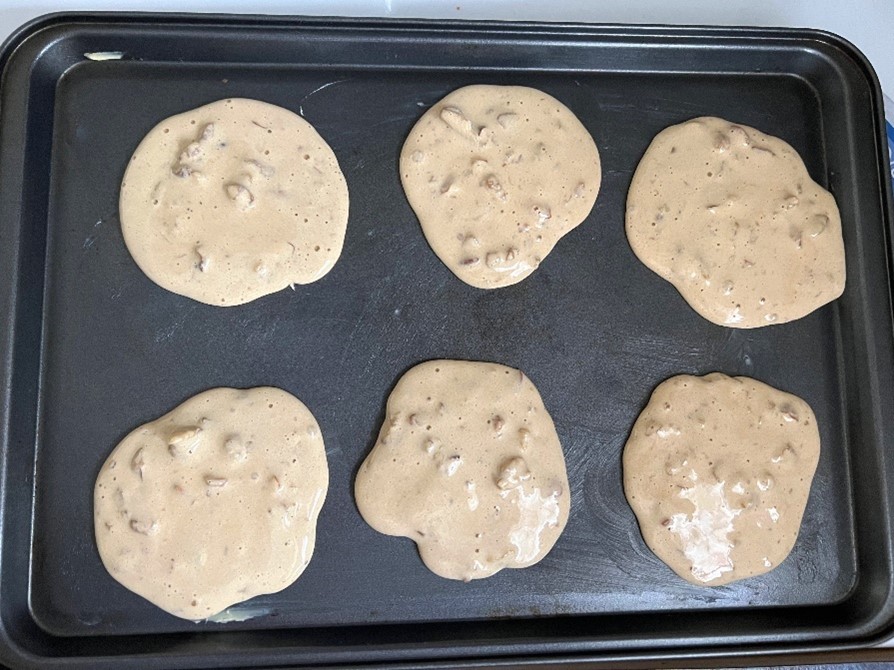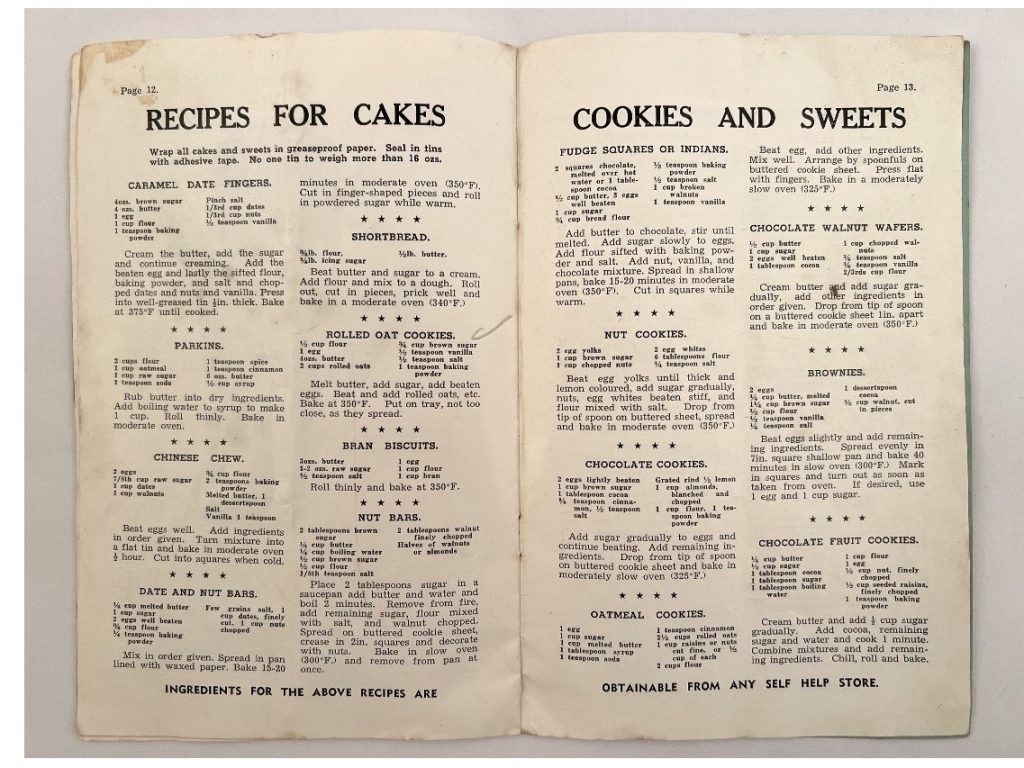When serving overseas, nothing could say ‘home’ quite as well as receiving a parcel of lovingly handmade baked goods. In 1940, Air Force Relations published a booklet of useful information, and an airman might have been lucky enough to sample some of the recipes it contained. But what were these recipes like? Well, they’re timeless, and just nuts.

Before I came to work in the archive at the Air Force Museum of New Zealand, I imagined it as rows of dusty boxes full of secret documents, a darkened hall with ominously placed lights, and maybe a few ghosts. Over the few months I’ve been here, I’ve learned this is… not too far off. There’s actually very little dust I’ve seen, and while most of the documents aren’t top secret like I thought, there are definitely some weird and wonderful things in there.
One, the catalyst for this blog, is a thin, unassuming booklet from 1940 entitled, “The Provision of Comforts to N.Z. Airmen at Home and Overseas: How You Can Play Your Part!”which instructed families on what useful things to send to sons, brothers, and husbands, and how exactly to make them. In amongst bits of other useful information are knitting patterns, and a few pages of recipes. Now, I might not be able to knit (at all) but I am a relatively good baker, so I decided to volunteer to make a few — and then inflict them on my family.
Nut Cookies
- 2 egg yolks
- 2 egg whites
- 1 cup brown sugar
- 1 cup chopped nuts
- 6 tablespoons flour
- ¼ teaspoon salt
Beat egg yolks until thick and lemon coloured, add sugar gradually, nuts, egg whites beaten stiff, and flour mixed with salt. Drop from tip of spoon on buttered sheet, spread and bake in moderate oven (350°F).
My first foray into 1940s baking was through “nut cookies”. Given the strangeness of this recipe, I couldn’t help but to dive straight in, as the beaten egg whites and 6 tablespoons of flour piqued my interest in quite an unfortunate way. It’s worth mentioning that while rationing of some essential items began in New Zealand in 1940, the rationing of food items didn’t begin until 1942, to preserve and ensure the maximum amount of resources could be dedicated to the war effort. While this recipe predates this, the lack of butter and limited use of flour does go to show that New Zealand was being prepared to ration as the war ramped up.
And truthfully, I should’ve also been prepared. I got thumb cramp almost immediately after beginning the first step of hand-whisking egg yolks, and spent the next few minutes staring wistfully at my stand mixer, who was happily whipping the whites. Before adding in the egg whites, I was prepared to consider this mix a cookie batter, but afterwards… Well. The batter was foamy, slightly bubbling, and a strange shade of beige.
It dripped, rather than dropped, from the end of the spoon onto the baking sheet, and after 15 minutes in the oven, had merged together. The undesirable texture had remained, and despite containing a mere quarter teaspoon of salt, it was the most prominent of the strange scents that wafted off the baked cookies. Honestly, I thought they tasted fine, if a little bland, a sentiment echoed by my cousin who described them as like chewing slightly flavoured foam. He later amended this, a faraway look in his eyes as he said, “Actually, they taste like a discus.”
3/5 stars.

Chocolate Cookies
- 2 eggs lightly beaten
- 1 cup brown sugar
- 1 tablespoon cocoa
- ¼ teaspoon cinnamon
- ½ teaspoon salt
- Grated rind of half a lemon
- 1 cup almonds, blanched and chopped
- 1 cup flour, 1 teaspoon baking powder
Add sugar gradually to eggs and continue beating. Add remaining ingredients. Drop from tip of spoon on buttered cookie sheet and bake in moderately slow oven (320°F).
Having received limited instructions once more, I set about trying to figure out what a “moderate” oven meant. I thought it might refer to timing, but apparently a “moderately slow” oven means 160°C, which I had already worked out from the Fahrenheit suggestion, so I was again left guessing how long to bake these for. Given what modern recipes suggest, I settled on 15 minutes, and hoped that would work. The flavours of this particular recipe intrigued me more than I’d like to admit, a theme that continued, because the mixture didn’t smell like anything at all until I added the lemon rind, after which it just smelled like lemon. My theory about these cookies was that perhaps the salt and cinnamon would enhance the flavours of the cocoa powder, but unfortunately, I was wrong. Once baked, these did not taste like chocolate, which I think is down to the lemon rind, and using a cup of almonds to stretch the mix. The texture was — not for the first time, and certainly not the last — springy, more like a muffin than a cookie, and considerably drier.
I can’t say whether they improved with time because I didn’t bother trying them again after the disappointment of them fresh from the oven, but my mother described them as “certainly a cookie” so that’s something. My grandmother seemed to finish hers rather reluctantly, and only out of support for my endeavours, but my grandfather nodded and declared them “smaakliek!” (which means “tasty”, for non-Dutch speakers). My uncle rather colourfully compared his to plasterboard and threw it out.
A rather mixed bag of reviews, but perhaps I have found a solution to the current gib shortage. 2.5/5 stars.

Fudge Squares or Indians
- 2 squares chocolate, melted over hot water or 1 tablespoon cocoa
- ½ cup butter, 3 eggs well beaten
- 1 cup sugar
- ¾ cup bread flour
- ½ teaspoon baking powder
- ½ teaspoon salt
- 1 cup broken walnuts
- 1 teaspoon vanilla
Add butter to chocolate, stir until melted. Add sugar slowly to eggs. Add flour sifted with baking powder and salt. Add nut, vanilla, and chocolate mixture. Spread in shallow pans, bake 15-20 minutes in moderate oven (350°F). Cut in squares while warm.
Looking at this recipe, I had such high hopes because it doesn’t seem too far off from modern recipes. Chocolate was soon to be rationed when this recipe was published, which explains the suggested substitute of cocoa, but as I have full access to chocolate, I decided to use two squares (roughly 40g) of baking chocolate. I melted this down in an improvised benchtop bain-marie, and for the briefest of moments, as I added the butter, I felt confident in this recipe’s ability to taste good.
And it did — at least, the batter did. Despite being the third recipe in a row to use a full cup of nuts, the batter was delightful. It was flavourful, not overly sweet, and the vanilla shone through the chocolate. It tasted better than I expected, and while I expected it to fade a little through baking, I thought it might still be the shining star of my experiment. But alas, it was not meant to be.
While not terrible, they weren’t what I had expected from the promise of the batter. The top layer of the squares had become sticky and peeled off with minimal effort, like skimming the skin from warm milk. My family was also largely unimpressed, especially by how dry they were. However, they were far from terrible, and get a respectable 3.5/5 stars.
As a small reminder, in case you’ve decided to make any of these recipes — if you’ve made a bain-marie and used the bowl you’ll later mix everything in, make sure it’s cooled down first. If you add eggs into a hot bowl, they’ll cook at least slightly, and you’ll ruin your efforts with chunks of gently scrambled egg in your baked goods.

Rolled Oat Cookies
- ½ cup flour
- 1 egg
- 4oz butter (113.4 grams)
- 2 cups rolled oats
- ¾ cup brown sugar
- ½ teaspoon vanilla
- ½ teaspoon salt
- 1 teaspoon baking powder
Melt butter, add sugar, add beaten eggs. Beat and add rolled oats etc. Bake at 350°F. Put on tray, not too close, as they spread.
Initially, I chose this recipe due to the amount of oats it used to create the illusion of a healthy choice. This does, of course, ignore the almost-cup of sugar in the ingredients. I was also intrigued by the need to put a warning that these would spread, which lingered in my mind as I once again whisked together a mixture that looked like caramel. With the vanilla and oats added, the mixture now looked and smelled like Anzac biscuits, once again bringing my hopes up.
It was with the ominous warning about spreading in mind that I buttered my largest baking sheet, dropping six thoroughly socially distanced piles on it. This turned out to be rather pointless, because they barely spread and stayed as the nice little mountains I had made them into. Coming from the oven, they smelled buttery and delicious, even if they were the fourth end result I could only describe as “bouncy”.
They were utterly delicious. Warm from the oven, they tasted exactly like the topping of apple crumble, and catapulted to the position of my favourite so far. Once the bounciness subsided, my family agreed — they were not too dense, not too heavy, and were perfectly flavourful. The texture did concern me a little though, as I wrote in my notes, “Why is everything bouncy?”
However, that’s a small flaw, and one I’m more than willing to overlook. 4/5 stars.

Nut Bars
- 2 tablespoons brown sugar
- ¼ cup butter
- ¼ cup boiling water
- ½ cup brown sugar
- ½ cup flour
- ⅛ teaspoon salt
- 2 tablespoons walnuts, finely chopped
- Halves of walnuts or almonds
Place 2 tablespoons sugar in a saucepan, add butter and water and boil 2 minutes. Remove from fire, add remaining sugar, flour mixed with salt, and walnuts chopped. Spread on buttered cookie sheet, crease in 2 inch squares and decorate with nuts. Bake in slow oven (300°F) and remove from pan at once.
Before I made this one, I imagined a vastly different consistency than I ended up with. I don’t know if I didn’t properly comprehend this recipe, but I completed the first step with the smallest pot I own — a 12cm diameter — thinking it would be a temporary container. However, with the liquid concoction bubbling happily, the half cup of sugar melted down easily, barely changing how much was in the pot. With only the dry ingredients and chopped nuts left to add, I still had plenty of room, and added it in.
I don’t know why they recommended baking this on a cookie sheet, because the mixture didn’t fill even my smallest baking tray, either before or after baking. This wasn’t the only issue I found with this recipe — being told to “crease” the mix before baking was simply not going to happen, because how do you crease something that is essentially a liquid? I quickly gave up trying to do that after the mixture stuck to my knife, decorated the top with almonds, and threw it in the oven for a bit.
The removal process was difficult, seeing as the “bars” were essentially molten caramel that stuck together and burned my fingertips as I tried (mostly in vain) to separate them. Unfortunately, it might be a process I’ll have to work at perfecting, because my family loved these. To be fair, they are quite tasty, because the simplicity of sugar and nuts doesn’t fade into nothingness. The texture, too, was pretty good. Despite the edges being quite hard, the centre ones were rather soft, similar to brownies.
In hindsight, I probably should’ve baked these a bit longer, because these recipes were likely created with use of a coal range in mind. I’m a little scared to consider what this might have done to the already-crisp edges of the nut bar slab, but overall, they were a refreshing contrast to the other dry, bland recipes, so it’s difficult to fault them. 4.5/5 stars.



